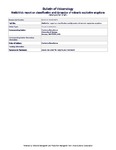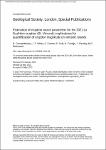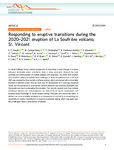MeMoVolc report on classification and dynamics of volcanic explosive eruptions

Date
2016-11Author
Subject
Metadata
Show full item recordAbstract
Classifications of volcanic eruptions were first introduced in the early twentieth century mostly based on qualitative observations of eruptive activity, and over time, they have gradually been developed to incorporate more quantitative descriptions of the eruptive products from both deposits and observations of active volcanoes. Progress in physical volcanology, and increased capability in monitoring, measuring and modelling of explosive eruptions, has highlighted shortcomings in the way we classify eruptions and triggered a debate around the need for eruption classification and the advantages and disadvantages of existing classification schemes. Here, we (i) review and assess existing classification schemes, focussing on subaerial eruptions; (ii) summarize the fundamental processes that drive and parameters that characterize explosive volcanism; (iii) identify and prioritize the main research that will improve the understanding, characterization and classification of volcanic eruptions and (iv) provide a roadmap for producing a rational and comprehensive classification scheme. In particular, classification schemes need to be objective-driven and simple enough to permit scientific exchange and promote transfer of knowledge beyond the scientific community. Schemes should be comprehensive and encompass a variety of products, eruptive styles and processes, including for example, lava flows, pyroclastic density currents, gas emissions and cinder cone or caldera formation. Open questions, processes and parameters that need to be addressed and better characterized in order to develop more comprehensive classification schemes and to advance our understanding of volcanic eruptions include conduit processes and dynamics, abrupt transitions in eruption regime, unsteadiness, eruption energy and energy balance.
Publisher
Journal
Volume
Issue
Pagination
Number
Recommended, similar items
The following license files are associated with this item:
Related items
Showing items related by title, author, creator and subject.
-
Estimation of eruption source parameters for the 2021 La Soufrière eruption (St. Vincent): implications for quantification of eruption magnitude on volcanic islands
Constantinescu, R; White, JT; Connor, C; Cole, Paul; Fontijn, K; Barclay, J; Robertson, R (The Geological Society, 2024-04)Eruption source parameters (ESPs) used to characterize explosive eruptions are estimated from tephra deposit data using different models (statistical or numerical) and inversion approaches. The ESPs thus derived are subject ... -
Responding to eruptive transitions during the 2020–2021 eruption of La Soufrière volcano, St. Vincent
Joseph, EP; Camejo-Harry, M; Christopher, T; Contreras-Arratia, R; Edwards, S; Graham, O; Johnson, M; Juman, A; Latchman, JL; Lynch, L; Miller, VL; Papadopoulos, I; Pascal, K; Robertson, R; Ryan, GA; Stinton, A; Grandin, R; Hamling, I; Jo, M-J; Barclay, J; Cole, P; Davies, BV; Sparks, RSJ (Springer Science and Business Media LLCEngland, 2022-12)Abstract: A critical challenge during volcanic emergencies is responding to rapid changes in eruptive behaviour. Actionable advice, essential in times of rising uncertainty, demands the rapid synthesis and communication ... -
The Impact of the Eruptions of the Soufriere Hills Volcano (Montserrat) on the Sea Floor Foraminiferal Biota
Wiggins, Jennifer (University of Plymouth, 2010-11-03T09:28:32Z2006)A census count of the benthic and planktonic foraminifera from the ash fall layer from the eastern side of the island of Montserrat exhibits a similar assemblage composition to that found on top of the Mt. Pinatubo ash ...



